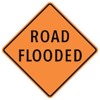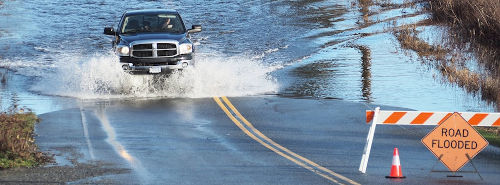 I learned early in my policing career that driving on a flooded road could be hazardous. What looked to be a few inches of water running on a city street hid a 2 m deep hole caused by a broken water line.
I learned early in my policing career that driving on a flooded road could be hazardous. What looked to be a few inches of water running on a city street hid a 2 m deep hole caused by a broken water line.
The 4x4 pickup driver who thought that this wouldn't be a challenge was very surprised when the front end of his truck dropped into the hole.

How Deep is Too Deep?
For an average car, 10 cm should be your safe limit. At 15 cm, water will reach the floor pan and has the potential to cause loss of control. 30 cm of water might be enough to set you afloat!
Damage to Electronics and Engine
Electronics contained in the vehicle seats, trunk floor and engine compartment could be destroyed if they get wet.
Some vehicles have engine air intakes at or just below bumper level. Ingesting water through this intake can destroy the engine.
Automatic transmissions have vents that could allow water to enter. This may result in expensive damage as well.
Insurance Considerations
If the water is deep enough to enter the passenger compartment ICBC advises that your vehicle could be considered as flood damaged and not repairable.
Vehicles designated as flood damaged can not be licensed in Canada.
Don't Make Waves!
If you have decided that the water is shallow enough to drive through, do it at low speed, perhaps 10 km/h or so. This will help to avoid loss of control or causing problems for others.
You Made It Through
Don't forget your brakes. If they are wet after passing through the water on a flooded road they may not work as expected until they dry out. Test your brakes and drive with caution until you are sure that they will stop you properly.
Flooded Road Notices
Check DriveBC.ca before you go. The best kind of problem is one that you avoid.
Video
Share This Article
- Log in to post comments
